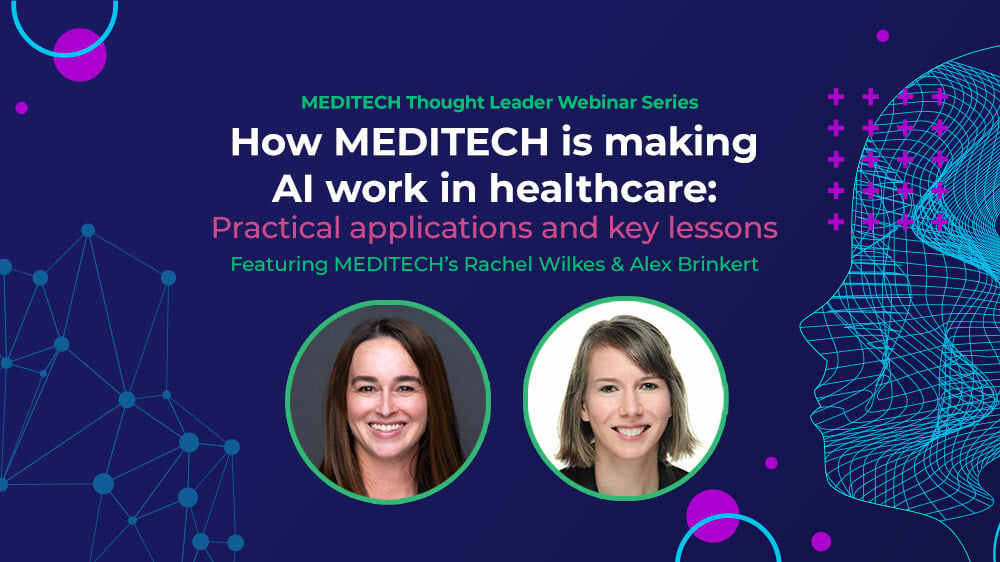
Whenever a new innovation is introduced, it follows a fairly predictable route from having its proof of concept tested to entering the market to maturing into a more refined solution that meets user needs and integrates smoothly within existing workflows.
It’s an evolution that we’re seeing now with generative AI — and, for the most part, we’re still in the early stages.
According to a recent Gartner ® Press Release, “Generative artificial intelligence (AI) is positioned on the Peak of Inflated Expectations on the Gartner, Inc. Hype Cycle™ for Emerging Technologies, 2023, projected to reach transformational benefit within two to five years.”1
Healthcare organizations and health IT vendors like MEDITECH are currently considering and exploring what that potential means — both now and when the hype around AI eventually cools down.
For MEDITECH, that means a thoughtful, deliberate approach, identifying and following clear guidelines for using AI in healthcare based on a commitment to deploy the technology safely. It also means having a vision for the practical integration of AI and using clinician satisfaction, patient experience, and organizational efficiency as guides for use case exploration.
So, how can today’s healthcare leaders make effective decisions about when and how to use AI?
We’ve identified three core pillars of the decision-making process, along with resources that provide a deeper understanding of each.
Know your terms and concepts
AI has become a catchall term for what is actually a variety of technologies with their own names and functions, including Machine Learning, Deep Learning, Natural Language Processing, and Large Language Models (LLMs).
When formulating an organization-wide strategy, it is essential to have a unified understanding of definitions.
Machine Learning, and its more complex subset of Deep Learning, involve using large datasets to train models to identify patterns and make predictions on their own. There are a few ways to accomplish this, including labeling the data and explicitly indicating what the model should learn from it, or allowing the model to identify connections on its own.
Foundation Models, a type of deep learning, are the basis for the current AI technologies receiving the most attention today. The key to foundation models is how they were trained – instead of requiring labeled datasets (which is a time-consuming process to create), these models are able to digest vast swaths of unlabeled data and begin to identify patterns and make correlations. These models are also able to put together what they have learned to enable the creation of new content – this is known as Generative AI.
Foundation models that were trained on text datasets are called LLMs. Prominent examples include BERT, GPT, PaLM, and MedPaLM. LLMs offer more accurate and efficient methods for completing Natural Language Processing tasks – the field of AI focused on training machines to understand human language, including the meaning of words and their relevance in various contexts. Recent advancements have resulted in a better understanding of the nuances of language, and the ability to respond in a more natural and conversational way.
For fields, like medicine, that are brimming with unstructured text data, LLMs offer significant potential to streamline documentation tasks and extract new insights.
Suggested resources:
- National Institute of Standards and Technology Trustworthy & Responsible AI Resource Center - Glossary
- McKinsey & Company: What is AI?
- The Alan Turing Institute: Data science and AI glossary
Decide what’s best for your organization
While there are a number of AI applications that can work for nearly all health systems, certain organizations will have more specific needs, depending on their resources, internal readiness to change, IT infrastructure, and individual pain points.
MEDITECH recognizes the challenges facing organizations who are exploring current and emerging forms of AI technology within the healthcare market, where staffing limitations and strong financial headwinds lead health systems toward solutions that improve efficiency and clinician satisfaction at a sustainable price point.
Ultimately, a solution’s usability will be a key factor for decision-makers, which encompasses the ease with which an AI solution can seamlessly integrate with a user’s workflow, its intuitive nature, and staff’s level of interest.
Amidst the AI hype, there is also an opportunity for organizations to take a closer look at ways to better leverage EHR functionalities that are available right now.
From fully optimizing their EHR for better personalization and more efficient documentation through Expanse Point of Care, to updating existing IT infrastructure to support cloud computing and the advanced processes that it can perform, like MEDITECH’s Patient Connect solution, health systems have tools available to address the needs of today’s healthcare workforce.
Suggested resources:
- 8 decision points to consider when implementing an AI solution by The Health AI Partnership (HAIP)
- Competencies for the Use of Artificial Intelligence-Based Tools by Health Care Professionals from the Journal of the Association of American Medical Colleges.
Establish guidelines and follow them
Government and industry groups have been developing ethical and practical guidelines for how to responsibly adopt AI in healthcare, and they all generally follow the same basic concepts: safety and security for users, ethical handling of data, minimization of bias and promotion of fair and equitable use, and heightened transparency.
These concepts are the building blocks necessary for creating trustworthy AI systems. Having an AI governance model inclusive of guidelines touching on each of these concepts ensures that decisions aren’t clouded by hype.
A good starting point is evaluating your current data governance model and how you keep data safe and secure as it moves through the system. All models require some form of data to produce an output – the better the quality and diversity of that data, the better the outcome. Becoming more familiar with how data flows throughout your organization should also provide further insight into whether and how to enhance data safety and security measures before implementing AI.
For example, an organization’s current cybersecurity policies might not address AI; in these cases, the same principles that support a robust and resilient digital security posture — secure storage and exchange of data and granular management of credentials for access — are applicable when integrating AI tools into the system.
Next, identify relevant stakeholders within your organization. These roles will span departments, including legal, executives, and end users in multiple locations. Use your organization’s strategic priorities to illuminate areas of focus, and begin researching use cases most aligned with your desired outcomes.
Take into account how you will measure effectiveness, train and educate staff and patients/consumers, incorporate AI solutions into pre-existing workflows, and make staff and patients aware of where AI is being implemented. You likely won’t introduce AI everywhere all at once — a measured approach allows for appropriate change management and monitoring.
Once your organization has established its own governance model for AI, it’s important when taking the next step to formalize policies that you remain true to the underlying principles that it sets out, even if — or, more to the point, especially when — the direction of a planned AI deployment changes in scope or purpose.
The future of AI in healthcare promises lots of change on the horizon — and we’re ready to continue our work with trusted partners to help customers navigate the challenges ahead.
Suggested resources:
- Artificial Intelligence Code of Conduct from the National Academy of Medicine
- CMS AI Playbook
- CHAI (Coalition for Health AI)
1Gartner Press Release, “Gartner Places Generative AI on the Peak of Inflated Expectations on the 2023 Hype Cycle for Emerging Technologies,” August 16, 2023. https://www.gartner.com/en/newsroom/press-releases/2023-08-16-gartner-places-generative-ai-on-the-peak-of-inflated-expectations-on-the-2023-hype-cycle-for-emerging-technologies
Gartner and Hype Cycle are registered trademarks of Gartner, Inc. and/or its affiliates in the U.S. and internationally and are used herein with permission. All rights reserved.
Learn more: How MEDITECH is driving AI innovations in health IT




